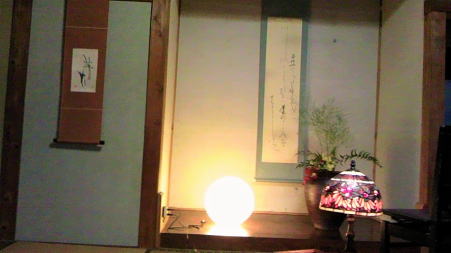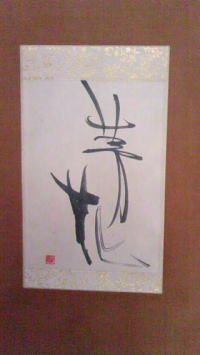お問合せ
事務局・工房くらし月
English top Concept Item list About us Contact
Japan's hand-written material
Fukiko Yasunaga (1920-2012)

Fukiko Yasunaga's work (left to the photo) : The Toki Museum
.
***********************************
Introduction
I came from outside Fukuoka, and I do not know about Fukuoka very well.
When I traveled in Eastern Europe, some person asked me if I knew "Carrot
Field School" which had existed in Fukuoka 100 years before. I heard about
"Carrot Field School" for the first time. So, when I came back to Fukuoka,
I visited some places as fieldwork.
The temple "Soufukuji" was one of them.
***********************************
Soufukuji is located by the East Park.
"East Park"is the birth place for Fukiko's mother, Haruko.
Fukiko's sister who was a nonfiction writer, Michiko Nagahata,
had a work related to "Carrot Field School".
I made some note about "Carrot Field School" as follows.
************************************
Note 1
The students in "Carrot Field School" were basically the local youth of
Fukuoka from the end of the Edo era to the Meiji era.
Note 2
I would like to compare Makoto Masaki who is on the List 1 to Tsuneki
Kurushima to illustrate their distinguished roles.
Makoto Masaki (1874-1943, Saga) on the List1 worked for the secretarial
office of the Cabinet of Shigenobu Okuma, and went to graduate school
after the Cabinet collapsed(1898).
“Tsuneki Kurushima(1860-1889, Fukuoka) from Carrot Field School ”,
whose gravestone is in “Soufuku-ji”, carried out the attack on Okuma
when Okuma was the Foreign Minister, and then Kurushima committed
suicide on the spot as sole offender.(1889).
Kurushima Tsuneki was born in the Edo period and lived in the turbulent
period of the "Liberal Rights Movement," while Makoto Masaki was born in
the Meiji Period and saw the result of the movement.
Makoto is an outsider of Carrot Field School and is mentioned for
comparison.
***********************************
Note 3
Takaba Osamu (1831-1891) was the founder of the Carrot Field School
(official name: Koshi-Juku) and the female doctor in male dress. She was
born in the Edo period as daughter of the prestigious "Takaba Family" who
served as an official doctor for Fukuoka Domain.
Osamu was raised as a boy for some family reason. She got married once
in her teens, but divorced. Then she studied at Kamei Juku in Fukuoka, and
opened her own school/Juku in 1873 (Meiji 6). Her school was located in the
field of medicinal ginseng, and was called "Carrot Field School"
***********************************
Note 4
The most famous person who studied at Carrot Field School is Mitsuru
Toyama (1855-1944), who entered the school at his late teenage.
This person had a very strong influence later in various fields on a broad scale.
***********************************
Note 5
A year after Tsuneki Kurushima committed suicide as sole culprit
of the bomb terrorism, OsamuTakaba passed away because of illness,
following the impression that he had wrongly used his courage.
As doctor, scholar, educator, she was deeply respected and
loved by her students.
***********************************
Note 6:
Near Hakata Station, there is the "Carrot Street" where several technical
schools are lined up. There is the "Carrot Park", and if you look for carefully,
you will be able to find the stone monument of the"Carrot Field School " on
roadside.
***********************************
I am sorry for the introduction and notes that became too long and
I would like to return to Fukiko.
Fukiko Yasunaga, a famous Tanka poet in the Showa era, was born and
raised in Kumamoto Prefecture. In Fukiko's essay her mother Haruko
appears with iconic colors such as “black long skirts” and “red apples”.
"White" is used symbolically for Fukiko's childhood memories.
For example, Fukiko wrote in one of her essays that when her mother,
Haruko, participated in the athletic meet of the Fifth High School
in Kumamoto, Haruko threw away her "white parasol" and ran fast.
(Reference: MizuAkari no Ki)
In 2011, "White" appears in the Tanka poem that 91-year old Fukiko
made when she was invited as a guest for the new year Tanka poem party
at the Imperial Palace. She made a Tanka poem of the white sasanqua
flower that her mother had loved.
A calligraphy gives us various different pictures. The article shown in
the picture was followed with Tsubana, white, Fukiko's mother Haruko,
East Park as Haruko's birthplace, Soufuku-ji, and Carrot Field School.
Fukiko wrote in the epilogue of her essay "Mizu Akari no Ki" that while
making a Tanka poem, there was a moment when a momentary view
came into her mind and that it was either a Tanka background or an
entirely different landscape, but in some scenes there were always
subtle parts which let her forget time and reconstruct the past.
It is a pleasure for us to imagine what the poet had fancied
while making a Tanka poem. So, "calligraphy" too.
***********************************
Other Information
* Fukiko Yasunaga was born in Kumamoto prefecture, later became
an honorary citizen of Kumamoto City.
*Makoto Masaki, who is being introduced on this site, entered
Fifth High School ( predecessor of Kumamoto University ) after
having graduated from Saga Junior High School.
**********************************************
*Fukiko's calligraphy in the photo is partly hidden under the thin stripe
called 'Ichimonji' put on the hanging scroll.
***********************************
English Top
The Toki Museum
Fukiko Yasunaga (1920-2012)

Fukiko Yasunaga's work (left to the photo) : The Toki Museum
 |
Imperata Cylindrica is called Tsubana or Chigaya in Japan, sometimes harvested from the wild for it edible, medicinal and other uses . Calligraphy: Fukiko Yasunaga Tanka poet / Calligrapher |
.
***********************************
Introduction
I came from outside Fukuoka, and I do not know about Fukuoka very well.
When I traveled in Eastern Europe, some person asked me if I knew "Carrot
Field School" which had existed in Fukuoka 100 years before. I heard about
"Carrot Field School" for the first time. So, when I came back to Fukuoka,
I visited some places as fieldwork.
The temple "Soufukuji" was one of them.
***********************************
Soufukuji is located by the East Park.
"East Park"is the birth place for Fukiko's mother, Haruko.
Fukiko's sister who was a nonfiction writer, Michiko Nagahata,
had a work related to "Carrot Field School".
I made some note about "Carrot Field School" as follows.
************************************
Note 1
The students in "Carrot Field School" were basically the local youth of
Fukuoka from the end of the Edo era to the Meiji era.
Note 2
I would like to compare Makoto Masaki who is on the List 1 to Tsuneki
Kurushima to illustrate their distinguished roles.
Makoto Masaki (1874-1943, Saga) on the List1 worked for the secretarial
office of the Cabinet of Shigenobu Okuma, and went to graduate school
after the Cabinet collapsed(1898).
“Tsuneki Kurushima(1860-1889, Fukuoka) from Carrot Field School ”,
whose gravestone is in “Soufuku-ji”, carried out the attack on Okuma
when Okuma was the Foreign Minister, and then Kurushima committed
suicide on the spot as sole offender.(1889).
Kurushima Tsuneki was born in the Edo period and lived in the turbulent
period of the "Liberal Rights Movement," while Makoto Masaki was born in
the Meiji Period and saw the result of the movement.
Makoto is an outsider of Carrot Field School and is mentioned for
comparison.
***********************************
Note 3
Takaba Osamu (1831-1891) was the founder of the Carrot Field School
(official name: Koshi-Juku) and the female doctor in male dress. She was
born in the Edo period as daughter of the prestigious "Takaba Family" who
served as an official doctor for Fukuoka Domain.
Osamu was raised as a boy for some family reason. She got married once
in her teens, but divorced. Then she studied at Kamei Juku in Fukuoka, and
opened her own school/Juku in 1873 (Meiji 6). Her school was located in the
field of medicinal ginseng, and was called "Carrot Field School"
***********************************
Note 4
The most famous person who studied at Carrot Field School is Mitsuru
Toyama (1855-1944), who entered the school at his late teenage.
This person had a very strong influence later in various fields on a broad scale.
***********************************
Note 5
A year after Tsuneki Kurushima committed suicide as sole culprit
of the bomb terrorism, OsamuTakaba passed away because of illness,
following the impression that he had wrongly used his courage.
As doctor, scholar, educator, she was deeply respected and
loved by her students.
***********************************
Note 6:
Near Hakata Station, there is the "Carrot Street" where several technical
schools are lined up. There is the "Carrot Park", and if you look for carefully,
you will be able to find the stone monument of the"Carrot Field School " on
roadside.
***********************************
I am sorry for the introduction and notes that became too long and
I would like to return to Fukiko.
Fukiko Yasunaga, a famous Tanka poet in the Showa era, was born and
raised in Kumamoto Prefecture. In Fukiko's essay her mother Haruko
appears with iconic colors such as “black long skirts” and “red apples”.
"White" is used symbolically for Fukiko's childhood memories.
For example, Fukiko wrote in one of her essays that when her mother,
Haruko, participated in the athletic meet of the Fifth High School
in Kumamoto, Haruko threw away her "white parasol" and ran fast.
(Reference: MizuAkari no Ki)
In 2011, "White" appears in the Tanka poem that 91-year old Fukiko
made when she was invited as a guest for the new year Tanka poem party
at the Imperial Palace. She made a Tanka poem of the white sasanqua
flower that her mother had loved.
A calligraphy gives us various different pictures. The article shown in
the picture was followed with Tsubana, white, Fukiko's mother Haruko,
East Park as Haruko's birthplace, Soufuku-ji, and Carrot Field School.
Fukiko wrote in the epilogue of her essay "Mizu Akari no Ki" that while
making a Tanka poem, there was a moment when a momentary view
came into her mind and that it was either a Tanka background or an
entirely different landscape, but in some scenes there were always
subtle parts which let her forget time and reconstruct the past.
It is a pleasure for us to imagine what the poet had fancied
while making a Tanka poem. So, "calligraphy" too.
***********************************
Other Information
* Fukiko Yasunaga was born in Kumamoto prefecture, later became
an honorary citizen of Kumamoto City.
*Makoto Masaki, who is being introduced on this site, entered
Fifth High School ( predecessor of Kumamoto University ) after
having graduated from Saga Junior High School.
**********************************************
*Fukiko's calligraphy in the photo is partly hidden under the thin stripe
called 'Ichimonji' put on the hanging scroll.
***********************************
English Top
The Toki Museum
news
ナビゲーションt
バナースペース
shop infoTHE TOKI MUSEUM
THE
TOKI
MUSEUM
PRIVACY POLICY
FACEBOOK
TWITTER
BLOG
JAPANESE
The Toki Museum